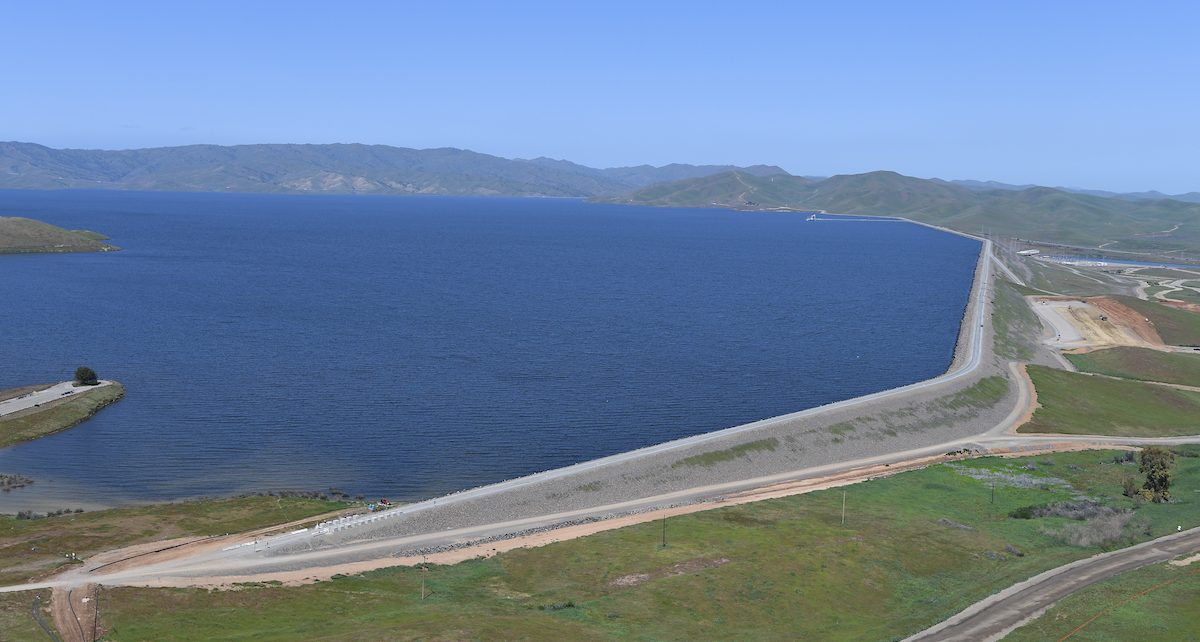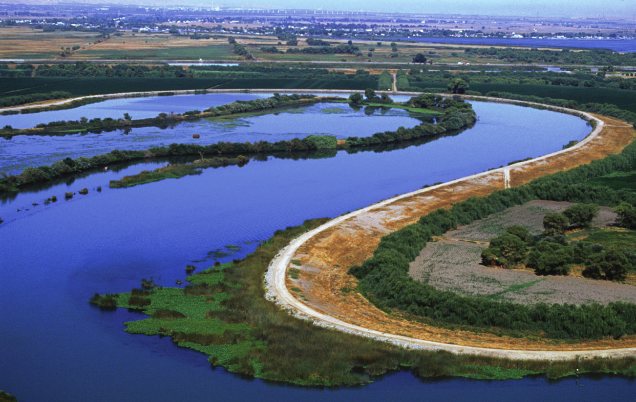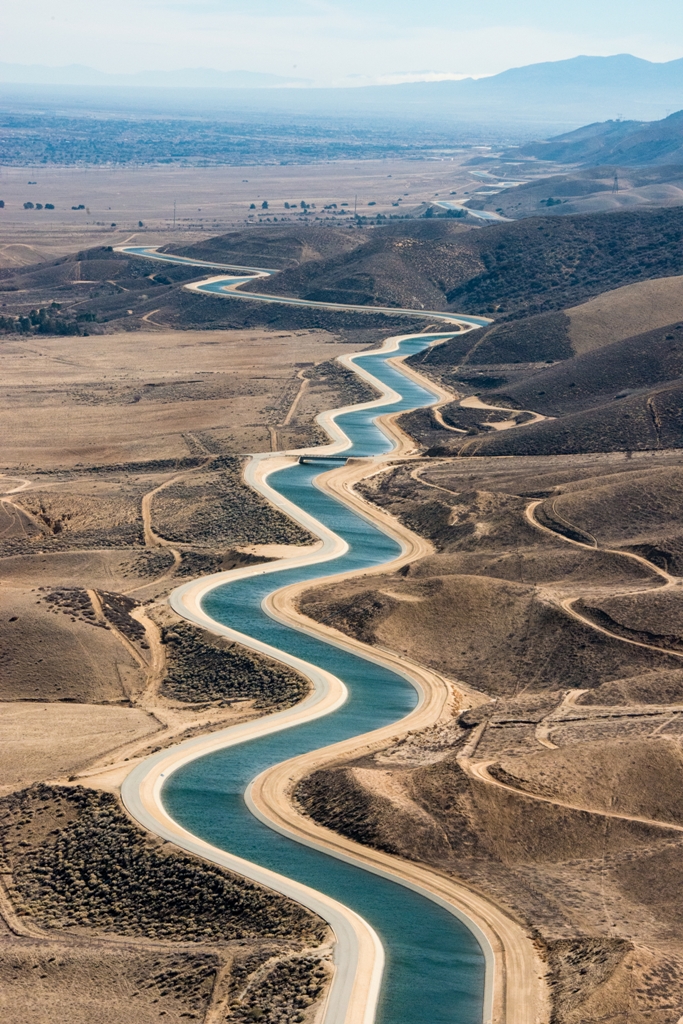
San Luis Reservoir (Photo: water.ca.gov)
Ringside: Eliminating Water Scarcity
These are the big three – depleted aquifers, nearly empty reservoirs on the Colorado River, and a precarious network of century old levees
By Edward Ring, December 20, 2023 10:38 pm
 After the deluge that inundated California during our most recent water season, there is no chance Californians will confront a water supply crisis this year. Water levels, as reported by the California Data Exchange Center, are above the historical average for this date in every one of California’s major reservoirs.
After the deluge that inundated California during our most recent water season, there is no chance Californians will confront a water supply crisis this year. Water levels, as reported by the California Data Exchange Center, are above the historical average for this date in every one of California’s major reservoirs.
But storms of scarcity remain on the horizon, and conservation is not enough. If conservation is our only approach, we will not conserve our way out of anything, not scarcity, poverty, inflation, or fragility, much less water. If rainfall totals are destined to permanently drop, then we must invest, innovate, and build. There is nothing Californians cannot do, so long as we apply our creativity and our wealth from an abundance mindset.
To reprise the theme that we believe will solve the problems of the world (nothing grandiose there), the only solutions that can deliver sustainability, equity, affordability and resilience in all things are policies that create abundance. Here are the some of the challenges that stand in the way of water abundance in California.
Overdrafted Aquifers: According to the Water Education Foundation, “on average, California uses about 2 million acre-feet of groundwater more than is naturally or artificially recharged. Much of the overdrafting has occurred in the agricultural Central and San Joaquin valleys.” Over the past ten years, Californians have, on average, pumped up 19 million acre feet (MAF) of groundwater per year. Based on these figures, to stop further depletion of groundwater, a 2 MAF/year reduction is needed. To recharge depleted aquifers, and possibly to account for less natural recharge if rain totals trend lower in the future, a much greater reduction is needed. To put this into perspective, California’s farmers require approximately 30 MAF/year and California’s cities consume another 7.5 MAF/year.
Diminished Colorado River Flow: If you wade through this very recent update from the Congressional Research Service, you will begin to understand the convoluted history (and future) of Colorado River management. To summarize, withdrawals for the past 20 years for urban and agricultural use have averaged 15 MAF/year, but total runoff has only averaged 12 MAF/year during that same period. The deficit was filled by nearly draining two of the biggest reservoirs in the U.S., Lake Powell with a capacity of 26 MAF, and Lake Mead with a capacity of 31 MAF. From both being almost full in 2000, by 2022 the lake levels had dropped down almost to so-called “Deadpool,” where the water is so low it can no longer flow downstream. The rain and snow last season brought lake levels up out of crisis range, but California’s 4.4 MAF/year share of Colorado River runoff is in jeopardy despite holding senior water rights. It is possible that future cuts could reduce California’s share significantly. More to the point, because we’re all in this together, experts at the Bureau of Reclamation and elsewhere have suggested that in the future the sustainable yield from the Colorado River could be as low as 9 MAF/year. That means California, along with six other states along the Colorado watershed, would have to find 6 MAF/year of cuts.
California’s North-to-South Aqueducts Depend on Delta Levees: The federally administered Central Valley Project employs a series of aqueducts to deliver water from Lake Shasta and other northern reservoirs down into the San Joaquin Valley. The California Water Project does the same thing, with Lake Oroville the centerpiece of a state-run system of reservoirs and aqueducts. Lake Shasta today has 3.0 MAF of water behind the dam, out of a total capacity of 4.5 MAF. Lake Oroville has 2.4 MAF currently stored out of a capacity of 3.5 MAF. But getting that water down to San Joaquin Valley farms and Southern California’s coastal megacities requires transiting the Sacramento-San Joaquin Delta. And safely moving fresh water through the delta requires intact levees. One major earthquake in the area – even as low as a magnitude 5 on the Richter scale – could cause “liquefaction” along multiple sections of the delta’s 1,000 miles of aging levees. Levee breaches would flood the “islands” protected by these levees – many now between 10 and 25 feet below sea level thanks to over a century of groundwater pumping. If that happens, salt water will pour into the delta from the San Pablo Bay, making north-to-south fresh water transfers impossible.
These are the big three – depleted aquifers, nearly empty reservoirs on the Colorado River, and a precarious network of century old levees that are one big earthquake away from catastrophic failure. And then there’s always the next severe drought. What can be done? Sacramento’s only consistent legislative strategy seems to be use less water. But exceptions exist.
Already approved by the State Assembly and set to go before the State Senate early next year, SB 366 includes encouraging language. If the state legislature, and, more to the point, the bureaucrats who will be tasked with implementation, can embrace the empowering imperative of abundance instead of the Malthusian tyranny of scarcity and rationing, there are words in the bill they can rely on. It directs the Department of Water Resources to “develop a comprehensive plan for addressing the state’s water needs and meeting specified long-term water supply targets…” and then, “require the plan to provide recommendations and strategies to ensure enough water supply for all beneficial uses.” Taken the right way, SB 366 can change the game.
California is at a crossroads. For every essential – not just water, but energy, infrastructure, housing, transportation, agricultural production, forestry, mining, ranching – the legislative and cultural bias has been to restrict production and ration consumption. The balance between the interests of California’s human population and needs of the environment has been lost, and, ironically, often these policies harm the environment more than they help. This Malthusian bias can and must change. It is out of character for Californians to think this way. And nobody, anywhere on earth, wants to copy this example.
Is it really preferable to carpet the land with solar panels, new transmission lines and battery farms, and saturate our coastal waters with thousands of offshore wind turbines, when two or three nuclear power plants and a dozen retrofit, ultra-efficient natural gas power plants could provide just as much energy with far less disruption to the environment?
Is it really preferable to spend an estimated $7 billion to implement SB 1157 (urban water rationing), in order to save an estimated 400,000 acre feet of water per year? For that amount of money, even at California’s inflated prices, you could build ocean desalination plants with the capacity to produce 400,000 acre feet of fresh water per year, and doing so would only consume 160,000 megawatts of electricity, a pittance. Desalination is the most expensive option to supply more water. Every other solution would cost less. Why are we preparing to put Californian households through this ordeal?
Resolute certainty can be the enemy of progress. There could come a day when we realize we impoverished our population while at the same time we spent countless billions to install what will have become a colossal pile of obsolete junk. Such is the danger of betting big on ephemeral technologies.
- Ringside: Will the Delta Pumps Operate at Capacity this Winter? - December 18, 2025
- Ringside: Will Advocates for More Water Supply Projects Find Unity? - December 11, 2025
- Ringside: EVs and California’s Future Demand for Electricity - December 4, 2025





The criminal Democrat cabal in California are all about creating water scarcity? It’s one of their methods to control Californians and making them dependent?
As usual, a fantastic analysis of the problem, and RATIONAL assessment of the potential solutions to it, by Mr. Ring…
HOWEVER, California is ruled by a bunch of IRRATIONAL, emotionally-driven, AND power-mad Democrats, who have also conveniently installed electronic voting systems WITH KNOWN AND DESCRIBED security-weaknesses and “backdoor exploits” as per a PDF that is still on the CA Secretary of State’s website.
Until enough people are hurt economically to force a political change of will and leadership in California legislation and governance, California will continue to be hamstrung by insane leftists like Weiner, Wicks, Ting, Low, and the newly emergent young guns out of SoCal, who are trying to out-crazy the crazies out of NorCal.
And then there’s Newsom, who wants to be pResident, after the current insane asylum, corrupt dementia patient is asked to step aside because he’s too old to continue to publicly function without drawing scrutiny…
Dark times, indeed….
I only hope someone reads this article and decides to change the power structure in Sacramento